About a week ago a Facebook post appeared in my email 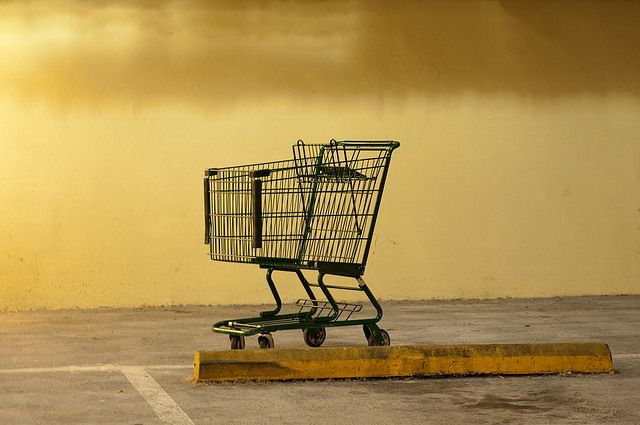 inbox from one of my patient’s Facebook page. I have no idea why it appeared as I usually only get such things from my own Facebook page, not anyone else’s. But the post was a picture of a Whole Foods shopping cart – you know, those cute little baby sized carts they have. In the cart were just enough food items to almost cover the bottom of the cart, leaving 70% of the cart empty. The caption on the photo said “your total is $192.88” and the post was lamenting the high cost of eating healthy food.
inbox from one of my patient’s Facebook page. I have no idea why it appeared as I usually only get such things from my own Facebook page, not anyone else’s. But the post was a picture of a Whole Foods shopping cart – you know, those cute little baby sized carts they have. In the cart were just enough food items to almost cover the bottom of the cart, leaving 70% of the cart empty. The caption on the photo said “your total is $192.88” and the post was lamenting the high cost of eating healthy food.
I actually responded to the post, something I never do. Here is what I said:
“Look at the cart – real food is not that expensive, but organic imitations of crap prepackaged foods are outrageous. Eat real vegetables and meats grown locally from farmer’s markets and farms and your grocery bill will go way down and your health will do much better.”

A second patient interaction brought the message this was showing me back to the forefront of my awareness and ultimately prompted me to write this article. I was sitting in the waiting room during my morning break eating a breakfast of some fried cabbage. My next patients walked in and asked me what I was eating, and when I told them they wanted to know how I made it. I said I simply put a little bacon grease in a frying pan and threw in a pile of chopped cabbage and stir-fried it with a little fish sauce and some black pepper. Their jaws dropped in amazement as they said, “You use bacon grease?” I said “Sure, as long as it comes from good bacon.”
What followed was an explanation about the health value of saturated fats and how the government has been lying to us for the last 60 years in order to promote the vegetable oil industry. But what the conversation really drove home to me is how our government has lied about what health food is and what food in general is and this lie has been driven into everyone’s brains. Between the government, agribusiness, and the food processing industries, folks no longer know what food even is. Convenience calories and tasty food drugs have replaced actual food in the American diet. These are marketed and sold in the same way drugs, alcohol, cigarettes, and other addictive substances are sold, because that is exactly what they are.
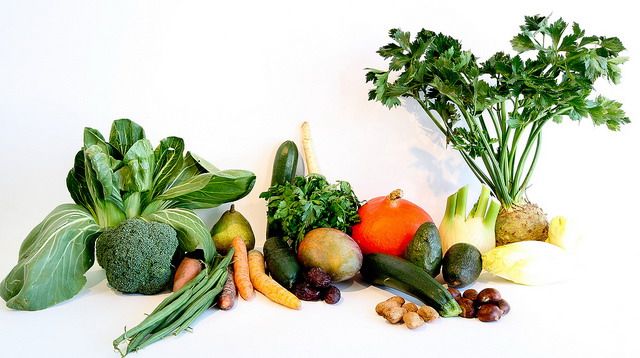
Have you noticed the complete absence of sexy marketing ads for cucumbers, carrots, chicken, and butter? Real food is not sexy. More importantly, the profit margin on real food is low so they can’t afford expensive marketing campaigns. Your grocery store might be making 5 to 10% profits on real foods. But look at your $4 box of breakfast cereal. It has about 20 cents worth of actual food in it. The box it comes in is often more expensive than the cereal inside. To make this groovy and organic, you use 30 cents worth of organic ingredients and jack the price up to $5 a box because now it is a “health food.” We are talking mega profits here. That is why most health brands are now owned by big businesses like Clorox, Coca Cola, Kellogg’s, General Mills, Kraft, and Pepsi. Check out some of your favorites here:
Now I have no problem with businesses running at a profit, but I do have a problem with misrepresenting products and buying government influence to promote public beliefs that are lies in order to sell more goods. But that is a story for another time. My big interest today is about why shopping has become so expensive. The reason is because the consumers are busy buying these massively overpriced high profit pretend foods. As a consumer, if you want to get good value for your money, buy low profit real foods. A good rule of thumb is that if a food is advertised, it is overpriced. It has to be overpriced to pay for the advertising.
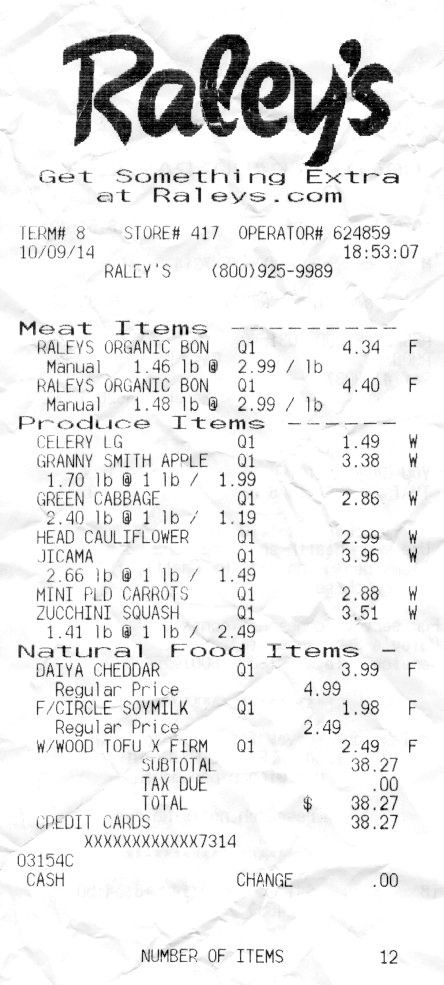
Let me give you my most recent grocery shopping trip as an example and a comparison to the $192.88 shopping trip to Whole Foods. Last Thursday I went shopping for a few days worth of food. I went to the Raley’s a few blocks from my house. When I go to Raley’s I shop the real food section of the store: the center aisle and the back wall of the store. The center aisle is where the vegetables and fruits are and the back wall is where the meats are located. I picked up a bag of carrots, a bag of Granny Smith apples, a head of cauliflower, a bag of zucchini, a cabbage, and a jicama from the center aisle. Cruising to the back wall I picked up two packages of organic free range chicken thighs. Then I swung through the health food section and picked up a double brick of sprouted tofu, soy milk, and a package of Daiya imitation cheddar shreds for Ellen. This netted me four bags of groceries for a grand total of $38.27.
When I got home I threw the thighs in a pan with a tablespoon of bacon grease and some salt and pepper to brown them, then I placed them into a baking dish in the oven to bake for an hour. Next I popped the cauliflower into a steamer basket in a big kettle with some water and put it on to steam. While that was steaming I cored and sliced the apples, put them back in the bag they came in with some Dr. Dave Double sugar, cinnamon, and vanilla, and shook them together. I then slid them into another baking dish I had greased with some coconut oil to bake in the oven with the chicken. By then the cauliflower was done so I let it cool a minute then dumped it into my Vita Mix with some avocado oil, some fish sauce, and some natural chicken bouillon. I blended this up on high to make mashed cauliflower “potatoes”. In this instance I added some horseradish and black pepper to give the “potatoes” a little kick. Once it was blended, I placed it into a glass container and put it into the fridge. Finally I put all the remaining vegetable into the fridge. They were to be replacements for the same veggies I had used earlier in the week to make a vegetable stew.
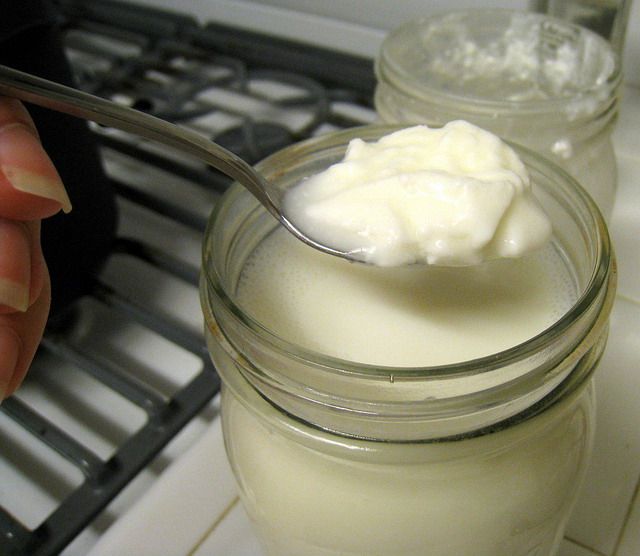
For fun I decided to try to make a soy yogurt for Ellen (I don’t use soy as I am a male and don’t need the estrogen mimickers found in soy.) I used one of the bricks of sprouted tofu – sprouted because sprouting destroys many of the bad properties of soy. I put it in the Vita-mix along with the soy milk and blended it on high. I then added a dollop of maple syrup to give the bacteria something to eat and opened two capsules of probiotics and added it to the mixture. After a little more blending, I then poured the contents into clean Mason jars and set them in a warm place. In our house that is the top of the water heater. By this time everything was done in the oven, so now all I had to do is put everything into glass containers for the fridge once it cooled. At this point I washed all the pans and put everything away. Total time elapsed from driving out the driveway to the store to finishing cleanup – 2 hours.
The chicken provides enough protein to last me for 6 days. The vegetables are all I need for vegetable stew for about 5 days. Half the cabbage I slice up for frying for my morning breakfast at 11:00am the next day. The Jicama is my crunchy snack for whenever. The cauliflower “mashed potatoes” goes with my piece of chicken for lunch at 1:30pm and I have my stew for dinner around 6:30pm. Sometimes I’ll also have a spinach salad with a few sliced almonds on top and a dressing made with the homemade Brain Power mayonnaise I wrote about a few weeks ago. The apples serve as a little sweet snack at lunchtime and dinnertime.
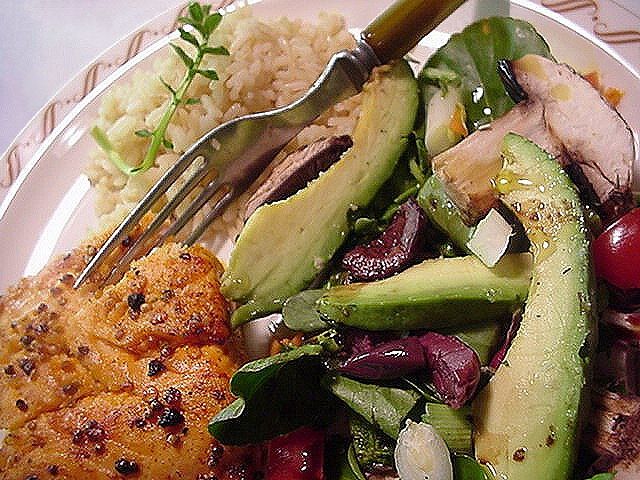
The point of this whole letter is let you know that eating healthy does not have to cost a lot, nor does it have to take a lot of time. I generally cook once or twice a week and eat from what I have made for the rest of the week. On the weekend Ellen and I will generally go out to dinner and a movie to spice things up a bit.
Groceries for a whole week of healthy food might cost $50 per person. The time investment is a couple of hours once or twice a week. This is very doable. The cost is so low because we avoid everything that comes pre-made and put in a package that can sit on a shelf. We focus on fresh foods prepared by ourselves as needed. Convenience increases food costs 400% to 1000%. My income is not going up nearly as fast as food costs, so convenience foods just don’t make sense financially. I have avoided them forever because they are so dangerous for our health, but these days they are simply too damn expensive as well.
Enjoy,
David
